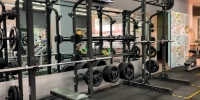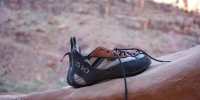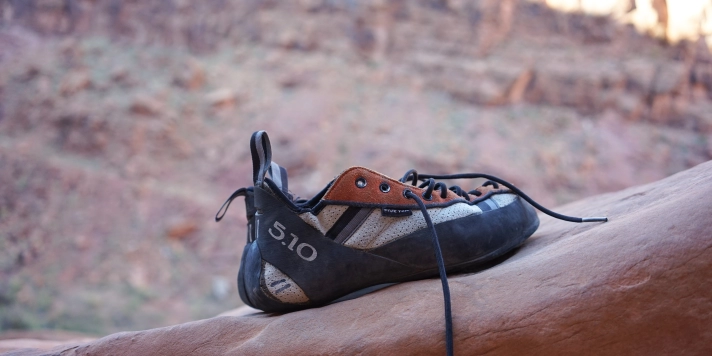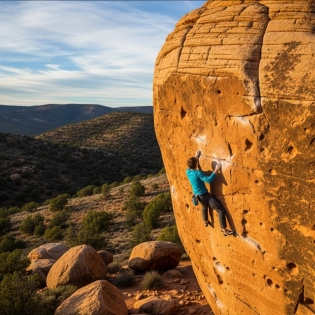








climbing shoes
Climbing shoes are not meant to hurt, they are meant to be tight, which for some, do mean that they may hurt a little bit.
How tight they should be, though, depends on the climber.
Climbers need their climbing shoes to be tight so that they can stand on very tiny and delicate holds, and for their feet to no slip or move within the shoe, or at least to minimize that as much as possible.
This, though, is usually a requirement of high level climbers, those who have been climbing for years and can actually benefit from the added performance the shoes can give.
Beginner climbers on the other hand have no reason to wear shoes that are so tight, as the routes they will be climbing will not require such delicate and precise feet placements, and will not have such small holds.
As climbers progress up the grades and climb harder and harder routes, it does make sense to start getting tighter shoes, but only as required. There is no point in having super tight and expensive shoes if they don't actually bring you any value in comparison to beginner climbing shoes or to just looser climbing shoes, especially if the tighter shoes are just painful.
With all of that said, there is a slight level of pain that climbers may feel with climbing shoes, mainly with new shoes, but this has more to do with the fact that the shoes are just not comfortable, it shouldn't be actual pain.
Climbing shoes are not comfortable, and this discomfort may be the cause of some pain, but, this is temporary until your feet get used to climbing shoes.
Once you have been climbing for a while, you will actually start to feel quite comfortable in climbing shoes, and yes, you may even refer to them as "comfortable".
There is also a point to make about fitting the right shoe for the right foot.
Not all shoes fit everyone. So it is important to try on different pairs and to find the ones that actually fit your feet well. This is because climbing shoes are all made differently. They are made from different materials, and can have slightly different shapes and bends, especially in the toe area and the heel.
First, the real key to making climbing shoes not hurt is to actually buy the correct size, and to not downsize to the point where you are in unbearable pain.
Sizing down is fine, as long as you know what you are doing and not sizing down too much, and that you actually understand the concept of sizing down and how shoes stretch.
The other crucial key, assuming you have bought the correct size, is to just wear them and climb in them. That really is the best way to stretch them.
There are many different methods of stretching them, such as just wearing them in the house, sleeping in them, showering in them, and many others.
A quick search can show you a lot of crazy methods, which some may work, but, even after doing those methods and having the shoe actually stretch, when you put it on and climb in it, it still won't be comfortable since it was not stretched in the same way that you would stretch it while climbing.
When you climb, your shoes bend and twist in all kinds of ways, ways which can't really be mimicked by just walking in them, sleeping in them, or putting them in the freezer, or by any of the other strange methods. Your feet need to be in them and need to be what stretches them.
Just climb in them, they will stretch and fit your feet much better, and they will be stretched in according to the way you actually use them on the wall.
I remember when I bought my second pair of climbing shoes, the ones I bought to replace my beginner shoes I wore for 6 months. I ordered them online and bought a size and a half (at least!) too small.
They were extremely painful to wear, even to just stand in.
My friend, with many years of experience, kept saying it's fine and that I should just wear them and climb in them, and they will loosen up.
I did as he said, but this didn't really work. They did loosen up a little bit even after climbing in them for just a few minutes, they did feel slightly better, but they were still horribly painful to wear.
The reason is, they were just too small! Climbing shoes should not be too small to begin with, even if you are expecting them to stretch and loosen up.
Also, they were synthetic. Synthetic shoes do not stretch as much as leather shoes stretch, so even if they would have stretched eventually by using them and climbing in them, they would not stretch enough to actually make them not hurt, they were at least 1.5 sizes too small to begin with.
And those are the two main points that I have used since then when buying shoes and making them not hurt:
1. Understand what you are buying
If they are leather, they will probably stretch a lot after using them for a while, so if you buy a smaller shoe size, it will probably be uncomfortable in the beginning, or even slightly painful, but as you use them, they should loosen up to be a great fit, just as long as you don't go down in size too much, they shouldn't actually be really painful.
If they are synthetic, keep in mind that they will probably not stretch too much, and if you buy size 10, they will probably stretch at the most to 10.5. I have bought since then 4 pairs of shoes, all synthetic, and none of them have noticeably stretched. They are still as tight as I bought them.
So keep this in mind when buying shoes, since if you buy synthetic shoes that are a few sizes smaller while thinking that they will stretch after you use them and that they will be a good fit, you may be quite disappointed.
2. Wear them!
My friend was actually right, wearing the climbing shoes does stretch them, even for that session, making them much more bearable throughout the session compared to when you are just putting them on.
Of course, if you downsize synthetic shoes too much, like in my accidental case, wearing them probably won't help much. But if the shoes are properly sized to begin with, then you should be fine with just wearing them and climbing with them, they should stretch and loosen up.

Rock climbing shoes are simply called climbing shoes. Some who mainly do bouldering may refer to them as bouldering shoes, but those too are just climbing shoes.
Climbing shoes should be tight, but not painful. It is important to also differentiate between pain and discomfort, as climbing shoes are not comfortable, but should also not cause pain.
With that said, there can be slight amounts of pain when climbing in new climbing shoes, especially for new climbers. This is because climbing shoes tend to be pretty stiff out of the box, and it takes a while for them to break in, meaning, for them to get a little bit softer and to stretch a little bit.
For new climbers this will be felt a little bit more since they are not used to climbing shoes in general and to the tightness of them.
To know how tight your shoes should be, just keep in mind the reason the shoes need to be tight in the first place, which is to help improve your performance.
If you are a beginner climber, this means that you do not need very tight shoes, since the routes you will be climbing do not require a high level of precision. You will most likely not be standing on tiny foot holds that require you to be precise and to trust your feet. You will also not be using your heel to the extent that it must be very tight.
If you are a more advanced climber, then understand what you are expecting from your shoes. They should be tight enough to be able to allow you to stand on tiny foot holds, to trust your feet, and for your heel to not move inside the shoe. This means that you will need a tighter climbing shoe than a beginner climber would need. Though, this does not mean that the shoe must be painful, it just needs to be a good fit for the shape of your foot, and tight enough that it will give you all of its benefits, but none of the pain (or as little as possible).
It is also important to understand that not all shoes fit all feet. Some climbing shoes, even when trying on larger sized shoes, will not fit your feet and will cause pain regardless of the shoe size. This is because climbing shoes have different shapes and features, so it is important to try on different shoes and to find the ones that fit the shape of your foot the best, and then to choose the correct size that will be tight enough for your needs, but also not so tight as it will cause you pain, preventing you from even climbing in them.
Another point worth mentioning: Don't size down just to size down!
Many climbers think that climbing shoes must be a certain size below their street shoe size, so they buy climbing shoes that are 2 or 4 sizes smaller (some even more!), and just climb through the pain. This is very bad practice as it can cause you to not only not want to climb due to the pain, but can also be very dangerous for your feet! Don't think about sizing down when trying on climbing shoes, just get the shoe that you feel the most comfortable in and that feels right. Some people go up in climbing shoe size from their street shoe size because it just feels the best for them and gives them the performance they are looking for.

Yes, climbing shoes can get wet. In fact, many people wash them to clean them, some even put them in washing machines too (I have never tried it, there is quite a bit of debate on the washing machine approach).
Also, while climbing, even if it's not really noticed, people sweat in their shoes, especially in the summer and when climbing outdoors. It's very common to take off climbing shoes to find out that the insides of yours shoes are pretty wet.
Climbing shoes normally do not shrink, they actually stretch and get looser.
The amount at which they stretch depends on the material the shoe is made of, and of course, on how often the shoe is used. If climbing shoes are rarely used, or used not frequently, they will take much longer to actually stretch.
The material the climbing shoes are made of plays an important role in how much the shoes actually stretch. Leather shoes tend to stretch quite a bit, which is part of the reason why many climbers buy shoes that are smaller than their actual climbing shoe size, since they know that after some time, the shoes will stretch and will be a good fit.
Climbing shoes that are synthetic and not leather tend to either not stretch at all, or stretch very little. I have quite a few pairs of non-leather climbing shoes, and I cannot say that I have noticed any stretching in the shoes, and I climb 3-4 times a week. They still feel as tight as the day I bought them, just used.





